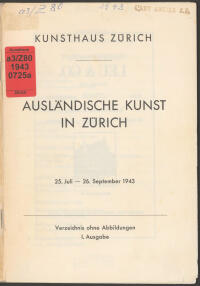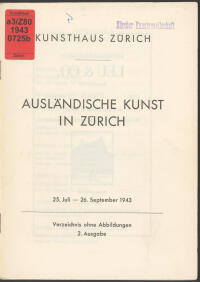Ausländische Kunst in Zürich. 306 Künstler
25.07.1943 – 26.09.1943
Location Kunsthaus.
Location Kunsthaus.
Zurich in Competition with Winterthur, Basel, and Geneva
In summer 1943, when the national borders were closed, Kunsthaus Director Wilhelm Wartmann wrote, referring to a poem by Schiller: ‘We have had more beautiful times’ – namely, when loans from all parts of Europe had been possible – ‘These times have now vanished.’ Now the Kunsthaus could have limited itself to local art, but the opposite was the case. Probably inspired by the widely noted exhibition ‘The Unknown Art Treasures in Winterthur, 1500–1900’, which had taken place in that city’s art museum a few months earlier, in an act of energy the Kunsthaus gathered together non-Swiss art from private collections in Zurich.
With one exception, the eight-three Zurich lenders were not named. They entrusted the Kunsthaus with a total of 607 works. These were supplemented with 224 works from the Kunsthaus collection, which were clearly labelled as property of that collection. The aim was a ‘tour through European art history’ beginning with the Middle Ages and ending with Klee, Mondrian, Léger and Picasso. The exhibition thus became a kind of demonstration of the achievements of local collectors of paintings, sculptures, and graphic prints. But Wartmann noted that the exhibition was ‘however, not a unit internally. It can be and remain a variety.’
The show was observed in all parts of the country and was widely discussed. The Gazette de Lausanne called it an ‘étonnante retrospective,’ which provided revealing conclusions about the cultural assets lying in the safes of Central Switzerland (sic) and also about the psyche of Zurichers generally (Jean-Louis Clerc). The Tribune de Genève could not resist comparing the quality of the collections in Geneva and Basel with those of Zurich – in which comparison the city on the Limmat came last. Nonetheless, the show was ‘remarquable,’ even if the contemporary section resembled a ‘gallery of the grotesque’ (Edouard Blaser). The NZZ received the exhibition well but also noted that abstract artists like Léger ‘don’t mean much to us’ (Doris Wild). Gotthard Jedlicka, art historian and co-editor of the magazine Das Werk, called the exhibition ‘courageous’: ‘The development of a public collection and thus also of private collections in our city cannot be better served than thus,’ The exhibition demonstrated that in Zurich one was on the path towards a creative principle of collection.’
With the exhibition appeared a catalogue with an introductory text by Wilhelm Wartmann and a list of works.
[Peter Stohler]
Further information
With one exception, the eight-three Zurich lenders were not named. They entrusted the Kunsthaus with a total of 607 works. These were supplemented with 224 works from the Kunsthaus collection, which were clearly labelled as property of that collection. The aim was a ‘tour through European art history’ beginning with the Middle Ages and ending with Klee, Mondrian, Léger and Picasso.

1/3
exhibition catalog

2/3
exhibition catalog

3/3
exhibition catalog
1/3